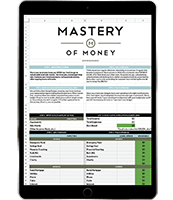“The American Dream is that dream of a land in which life should be better and richer and fuller for everyone, with opportunity for each according to ability or achievement. It is a difficult dream for the European upper classes to interpret adequately, and too many of us ourselves have grown weary and mistrustful of it. It is not a dream of motor cars and high wages merely, but a dream of social order in which each man and each woman shall be able to attain to the fullest stature of which they are innately capable, and be recognized by others for what they are, regardless of the fortuitous circumstances of birth or position.” – James Truslow Adams
American PI:E
Looking back now, I can see that the fear I had around separating from the military was largely financially-based. Money touches almost all aspects of our lives, whether we admit it or not. Like most people, all my working adult-life has been spent in the classic “active income” model. In other words, we exchange time for money in the form of a salary or commission, depending on the job we have. In formula-speak, this could look like:
AI:E (active income/monthly expenses)
The average worker in America now will change jobs 15 times in their working life. This is the reality of working our way through life, but it comes with friction. The act of changing careers constantly challenges our sense of freedom. Our fear of the stress a change can bring about breeds more stress, so we stay put in a cortisol-soaked fight-or-flight purgatory. A study recently released by Paychex showed that on a scale of one to five, five being super stressed, over 70% of workers reported a three or more.
The top three reasons for worker stress? Complicated or hard work, long or erratic hours, and lack of control. All these factors contribute to us feeling like hamsters on a wheel, constantly chasing that paycheck in the sky, only to end up exhausted and broke. It wasn’t until I separated from the military and began a career in investing and personal finance that I truly saw with my own eyes that there was a better way – a way to escape the cage and be the wild hamsters (a real thing?) we were meant to be.
Yes, I was introduced to the power of compound interest and passive income, but on a broader scale, I began to realize that the goal for most investing is not necessarily wealth for wealth’s sake – it’s also income generation. The answer is as easy as PI:E:
PI:E (passive income/expenses)
What is passive income? It’s earnings you get from real estate, investment portfolio income (dividends & interest), or enterprises with which you are not materially involved. If your income from passive sources covers your expenses (including allowances for wants and saving that allow you to maintain quality of life), you have achieved autonomy.
Since leaving the military, I’ve had the opportunity to ask thousands of people from ages 18 up what financial independence really means to them. The most common answers I get are:
- The ability to enjoy my money
- Not having to live paycheck to paycheck
- Knowing my money will last through retirement
- Being able to pay for kids’ college
- Travel – when and where I want
- Spending time with my family and not having to work all the time
What do these answers all have in common?
Autonomy
The definition of autonomy is “freedom from external control or influence; independence.”
A PI:E ratio of 1:1, or 100% funding = Autonomy
Simply put, if you have income coming in from passive sources that covers your monthly and annual expenses in perpetuity, accounting for things like inflation, a realistic expected rate of return on your investments, and a conservative withdrawal rate, then you have achieved autonomy. Autonomy allows us to pursue our passions, to allocate time as we see fit, to set our own agendas. Some would choose to actively work with their autonomy, but the point is that they choose to do it. Working in the PI:E model is no longer a function of need, but of choice. It is the freedom we all seek, but rarely articulate.
The good news is that this can happen at any age, as long as the math works.
Annie Dillard said “how we spend our days is how we spend our lives.” Most working Americans spend their entire lives working, seeking autonomy, only to enjoy it for a few precious years if they have done a decent enough job of saving, and brought to you by social security.
Let’s flip the script on retirement. It’s time to get passionate about taking control of our time, our money, our lives. Let’s take a look at some of the most common sources of passive income so you can start using discretionary active income to make some delicious PI:E.
Putting the PI in PI:E
1.Investment portfolio– Most workers invest in capital markets via employer-sponsored plans (e.g. 401(k)s and 403(b)s), Individual Retirement Accounts (IRA’s), and/or standard asset management accounts through online brokerage services and active-management firms. Dividend-paying stocks and interest-yielding bonds are popular vehicles for generating income from principal investments. Dividends are profit distributions from a company to it’s shareholders, usually set as a percentage of the share value. For example, if you own $1,000 of shares in company X, and company X declares that they will pay a dividend of 5%, you will receive a distribution of $50 – to take as income, re-invest, or invest in something else, you decide. Dividends are a great source of passive income from your investment portfolio but can vary from distribution-to-distribution based on fluctuation in the value of your shares, and the company’s decision-making. If you want to use dividends in your passive income strategy, look for companies with a track record of not only offering dividends, but increasing the percentage year-to-year. Then make sure your portfolio contains dividend sources that are distributed and staggered throughout the year to provide you with the cashflow you need without selling any shares.
Bonds are debt securities issued by firms or governments to raise money. In short, when you buy a bond you are lending money to the bond issuer. If you hold the bond until maturity, the issuer will pay you back the money to you loaned them, along with interest along the way. This interest is different from dividend income from stocks in that it is usually a fixed rate and can be counted as fixed income on a more secure basis. The risk? That your issuer becomes insolvent and can’t pay you back. If bonds are a part of your plan, look for highly-rated companies or government issues by rating agencies like Moody’s or Standard and Poor’s to hedge against this default risk.
Whether your mutual funds contain stocks or bonds, and in what percentage, is largely driven by your stage of life and tolerance for risk – both areas you should be comfortable with before you invest.
Of course you can always sell the investments themselves in your portfolio to take the proceeds as income in the year sold, but remember that you are reducing the base of your future income by doing so, or killing the goose that lays the golden eggs. There are restrictions and penalties for taking withdrawals from retirement accounts like 401(k)s and IRAs before age 59 ½, so make sure you’re pulling from non-retirement asset management accounts if you’re able to retire early. As always, talk to a pro to set up this passive income strategy if early retirement is in the cards for you.
2.Real estate – A large number of wildly successful passive PI:E-folios include real estate in one form or another. Some invest in rental units, some flip, and others skip the brick-and-mortar altogether by investing in Real Estate Investment Trusts (REITs). Flipping is more of an active (and risky) pursuit, unless you build a flipping company run by someone else that uses a model you have established. If going the licensed route is your plan, real-estate agents can build sustainable teams and relinquish daily control to the manager of the team, effectively accomplishing the same goal (see enterprise path below). REITs are companies that own, operate, or finance income-producing real-estate. Investors can buy shares of these companies just like a mutual fund and participate in the revenue generated by the underlying assets, without the hassle of dealing with tenants. Income from REITs can be taxed as either dividends or capital gains depending on whether or not they are qualified. If you do receive income from a rental, you can deduct expenses relating to your rental per IRS guidelines. As always, work with a trusted tax pro, especially if you’ve got a real estate business you’re looking to for passive income.
Regardless of how you decide to include real estate, understand how to calculate your return on investment, or “ROI” if you want to sound fancy at cocktail parties. This is a way to assess the performance of your asset as it relates to your original investment. There are many methods investors use to get to an ROI, but the main idea is to divide the net income from your property (income from the property after all expenses) for a given period by the amount you invested. If you used cash to purchase, then that’s the amount you invested. If you financed the purchase with a mortgage, make sure you include the cost of using that debt (interest) in your expense calculation. You net income (not gross) is the number you need to know as you build your passive income strategy.
3.Enterprise – Building a business, company, or practice that can ultimately operate and generate revenue (and profit) without you actively participating is the goal of many successful passive income warriors. In this area, there are two moves to consider – I call them the “Cuban” and the “Batman.” Entrepreneur/billionaire/shark/NBA owner Mark Cuban made his billions through the sale of Broadcast.com to Yahoo in 1999. Bruce Wayne lets Lucius Fox run Wayne Enterprises while he fights crime in spandex – two sides of the same coin! Many entrepreneurs build businesses with the goal to sell them down the road for a windfall, which they can then take to spend, give, or invest in another venture, investments, or real estate. Others hold on to their companies and let them cash flow their early retirement. Obviously, there are a lot of variables involved in either direction, but the point is to begin with the end in mind (aka an exit strategy). For some help as you go, consistently ask yourself these four transcendent questions.
4.Benefits– Don’t forget to factor in benefits from government (social security, disability) or from employers (pensions, less common nowadays). While taxes vary on these types of income depending on the source, perpetual income from benefits such as VA disability or social security if you’ve already started drawing should be factored into your plan. While income from government programs such as social security can be helpful, the risk involved for younger savers is that economic factors and shortfalls can threaten the longevity of any program. The solution? Focus your efforts on enterprise, real estate, and/or investment solutions – then if passive income from benefits fails to materialize, we’re still rockin!
American PI:E is about more than numbers – it’s about expressing our desire to achieve time and choice autonomy. Start to build your strategy in these four areas and set a course for financial independence. The recipe is clear: positive discretionary cash flow and effort committed to a passive income generating strategy over time – add in a heaping cup of patience, a dash of resilience, and a pinch of luck, and you’ve got one satisfying piece of PI:E.
Photo by: Photo by John Silliman

Derek Brainard – Manager of Education Services for AccessLex Institute and an Accredited Financial Counselor




